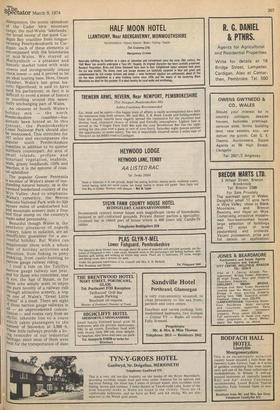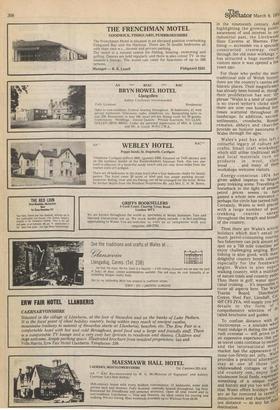A versatile and varied land
Roger Thomas
On the north Pembrokeshire coast there is an old whitewashed cot
tage, barely visible amid luxuriant hedgerows and the tall grass of a hill which sweeps down to the sea. Its name — the Watch Cottage
gives some indication of its previous use: the Pembrokeshire coastline is an intricate amalgam of coves, headlands, mini-fjords and bays and in the days when IA Customs were less than efficient (or non-existent) this was Marvellous smuggling territory.
The Watch Cottage, unobrusive in lo.cation yet commanding a cmemascope-like vista of a large Slice of ocean, proved to be the downfall of many a would-be smuggler. And its reassuringly thick walls must have kept those early protectors of our island rights warm even in the severest of winter gales.
This tiny cottage, with its dis
tinctive mortared roof, has stood the ravages of time and is in amazingly fine condition. It is now a holiday cottage and as such is representative of the distinctive accommodation Wales offers.
In a wide-ranging holiday which Look in South, Mid and North „Wales last year, a stay at the
watch Cottage occupied a few days of my time. Talking to other
visitors who had also chosen this
Particular stretch of the coastline, I Was struck by the element of
Pleasant surprise which most of them expressed. A typical cornrent, "We didn't expect Wales to
.r,ue quite like this" summed it up.
:,.he image of Wales as an area Which consists entirely of bold
,,111°untains (i.e. Snowdonia) and onPular Coastal attractions is now as obsolete as the simplistic idea that England is full of Beefeaters and over-decorated guardsmen. ,Wales's holiday scene it now cnaracterised by its tremendous versatility and variety. On a Voographic basis, the spread of liday facilities and amenities has been thorough: George Borrow, in 11,.18 Wild Wales, wrote of a dis ;pctive and characterful country. 1.131n. to explore it all he had to
4esort to remote mountain paths,
ePend on the hospitality of ose'lated farmhouses, travel on foot on horseback. While retaining uch of the qualities and it!laracteristics which prompted 115 to coin that vividly accurate
title phrase, Wales has also since his time experienced a tasteful and sympathetic growth in accommodation facilities and tourist amenities of all kinds.
The empirically minded will perhaps react more favourably to the fact that 1877 square miles (about 23 per cent of Wales's total land area) is taken up by either National Parkland or areas officially designated at being of "outstanding natural beauty." Within a compact geographic area is concentrated a marvellous array of scenery — high mountains, rolling borderland, rugged coastline, gracefully undulating hills and vales.
From Pembrokeshire we travelled up, closely following the great arc of Cardigan Bay, to North Wales. The stranger would be forgiven for thinking that this region is entirely synonymous with mountains, such is the omnipresent bulk of Snowdonia. Although this mountain range (in Welsh known as Eryri — "the haunt of the eagle") is now a National Park of extensive proportions, its craggy ranges, mountain lakes and hidden, steep-sided valleys have a perfect counterpoint in the coastal splendour of the Lleyn Peninsula and the Isle of Anglesey. These two areas both have their districts of "outstanding natural beauty," and it was on the southern flank of the former at the attractive castle-dominated resort of Criccieth that we decided to stay. The castle, perched on a hill overlooking the picturesque harbour, has an almost sinister air about it, while from its walls we could just make out across the Tremadog Bay on a clear day an even greater reminder of our none-too-auspicious past in the shape of the massive rampart of Harlech's Edwardian fortress, built in mediaeval times.
If North Wales is an area of dramatic contrast — popular and quiet stretches of coastline rising abruptly to commanding mountain peaks — the neighbouring mid-Wales displays an altogether subtler character. Here, the keynotes are unhurried and unspoilt calm, here the visitor can experience as genuine an evocation of the Wild Wales of old as he or she is likely to get.
The remote moorlands of Abergwesyn, the scenic-splendour of the Cader Idris mountain range, the mid-Wales lakelands,' the broad sweep of the quiet Car
digan Bay coastline from tongue-. twisting Penrhydeudraeth to Car
digan: each of these elements is
encompassed with the boundaries of mid-Wales. We stayed at Machynlleth — a pleasant and historic market town with wide streets and incongruously ornate clock tower — and it proved to be
an ideal touring base. Here, Owain Glyndwr, Wales's last great historic figurehead, is said to have held his parliament; in fact it is difficult to avoid a sense of history in travelling around this essentially unchanging part of Wales.
An element of South Wales's holiday mix — the north
Pembrokeshire coastline—has already been hinted at. In this context, the Pembrokeshire Coast National Park should also be mentioned. This stretches for 167 miles and encompasses the Popular south Pembrokeshire coastline in addition to its quieter northern counterpart. An area of small islands, profuse and luxuriant vegetation, seabirds, seals, grassy, headlands, cliffs and beaches, it is the epitome of coastal splendour.
The popular Gower Peninsula IS another of Wales's areas of outstanding natural beauty, as is the forested borderland country of the Wye Valley. And to emphasise Wales's versatility, the Brecon Beacons National Park with its 520 square miles of undisturbed hill and mountain scenery puts a firm and final stamp on the country's multi-sided personality. Beautiful though Wales is, the aesthetic pleasures of superb scenery, taken in isolation, are an insufficient guarantee for a successful holiday. But Wales can supplement them with a whole host of holiday activities and amenities, from fishing to pony trekking, from castle-hunting to narrow gauge railway riding. I took a ride on the Talyllyn narrow gauge railway last year, a. nd for those who remember, tear in eye, the Age of Steam, or for those who simply want to enjoy ,,t,be pure novelty of a railway ride inrough attractive scenery, a trip ,Chl on of Wales's "Great Little trains" is a must. There are eight of these narrow gauge railways in ail — an unprecedented concentration — and routes vary. from an idyllic lakeside line to a route Which takes passengers to the .„sUMmit of Snowdon at 3,560 ft. ,these little railways provide a liv!ng reminder of our industrial leritage, since most of them were °Wit for the transportation of slate Spectator March 9, 19741 in the nineteenth century.. And highlighting the growing public awareness of and interest in our industrial past, the Llechwedd Slate Caverns at Blaenau FfesI tiniog — accessible via a specially I constructed tramway route through the old mine workings — has attracted a huge number of visitors since it was opened a fey' years ago.
For those who prefer the more traditional side of Welsh history there are the country's castles and historic places. Their magnificence has already been hinted at, though their proliferation has not: the, phrase "Wales is a land of castles is no travel writer's cliche since there are over one hundred fort. resses scattered throughout the landscape. In addition, ancient settlements, cromlechs, Roman remains, abbeys and churches provide an historic panorama 01 Wales through the ages.
Wales's past has also left a colourful legacy of culture and crafts. Small craft workshoPs which still utilise traditional skills and local materials turn out products in wool, slate, wood . . . and many of these workshops welcome visitors.
Energy-conscious 1974 has given added impetus to Wales's pony trekking scene. Travelling oil horseback in the light of present petrol prices seems to have gained a whole new relevance perhaps the circle has turned fu11Y. Certainly, Wales is Well placed, with a large number of poll
trekking centres sprea, throughout the length and bread of the country.
Then there are Wales's activitY holidays which don't entail too much petrol-consuming touring' Sea fishermen can pick almost spot on a 750 mile coastline atv, enjoy challenging angling. Rive',I fishing is also good, with marl?, delightful country hotels cater especially for the freshwater angler. Wales is also superD walking country, with a multitude of nature trails and country paths. Then there is golf, water sports, canal cruising ... it's impossible 0'5 cover all aspects here. The Walen Tourist Board, Centre, Heol Fair, LlaDni diff CF5 2YA, will supply you Wit details in the form of comprehensive selection of de' tailed brochures and guides.
To confuse distance with chl, tinctiveness — a mistake Whicoi many indulge in during the anne dstafribuctiaorii: rush overseas — will prove to 1,0( an expensive experience this Yeo as travel costs continue to escala, and the international morie:0 market has the appearance tie none-too-firmly-set jelly. Wa e: provides a practical alternativie stay at one of those litta whitewashed cottages or in old country inn, enjoy fr' ce wholesome local foods, experierld something of a unique cultae,e' and history and you too will agrl.cii that Wales offers holidays Whof are as far removed in terns if distinctiveness and character a dneosttidniasttiaonnce — as any far




































 Previous page
Previous page